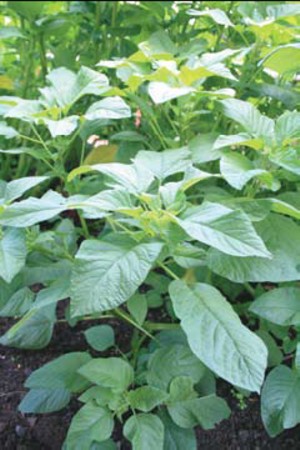Clever crop Amaranthus by Vasili
Amaranthus, also known as amaranth, is a herb with around 60 species, all quite easily recognised by their foliage, which ranges from purple to red to gold. At a glance, many people would consider amaranthus a weed, but don’t be fooled; in many countries it has been cultivated for hundreds of years as a leafy vegetable. In Africa, for example, it’s considered a traditional plant food and in many parts of Asia and America it’s grown for the production of grain. Amaranthus grows so easily it’s considered one of the most inexpensive crops to grow, so I suppose you can say it grows like a weed.
But what is the definition of a weed? Well, my definition of a weed is a plant that, without your consent, germinates in your garden entirely off its own bat, matures and blossoms, spreading wild seeds everywhere and eventually taking over the entire garden if allowed to keep spreading. So I suppose amaranthus must be a weed because it’s capable of growing in the most arid environment yet still able to produce huge quantities of fruit. What a weed to have growing in your garden! Did you know that amaranthus grain has at least 30 per cent more protein than rice, wheat flour, rye and many of today’s cereals? Tell that to Uncle Toby and Kellogg’s and I bet you’ll be eating amaranflakes and amaranthbits before you know it. Besides protein, amaranth grain is full of dietary fibre and minerals such as phosphorus, iron and manganese, and if you eat enough of it, it will even help prevent premature greying of hair.
So no more processed breakfast cereals and no more visits to the hairdresser to colour your hair, thank you very much. How about this bit of history? During Aztec ceremonies, amaranth was mixed with honey and shaped into images in honour of their gods, then cut out and eaten by the people. The word itself comes from the Greek word amarantos, meaning “one that does not wilt or wither” — just like the strong Greek boy I am. So when you are out in the garden, make sure you always have some honey handy in case you spot some amaranthus growing wild. Or enjoy eating it with a cup of freshly squeezed orange juice.
Nutrients per 100g
.222mg 4.2mg 40mcg 40mcg_DFE 69.9mg .208mg 1.286mg .080mg
| Vitamin B |
| Vitamin C |
| Folate, food |
| Folate, DFE |
| Choline, total |
| Riboflavin |
| Niacin |
| Thiamine |
Pests and Diseases
No fungal or bacterial diseases affect amaranthus.
Strawberry Lygus Bug (Lygus hesperus) Watch out for this — it’s the worst insect pest and it sucks on the flowers and seeds, which can cause yield loss by stopping seed development. Lygus eggs lie dormant during winter and rest in weeds such as butterweed, thistle, wild radish and dog fennel. Hand-pick these weeds and feed them to your chooks or get your chooks to come to them.
Blister Beetles (Epicauta spp) There are more than 100 species of blister beetles and they feed on the leaves and can be treated with organic insecticides. Use gloves to pick beetles by hand and be careful you don’t get toxic secretions on you. Spray full-strength canola oil on the plant and the beetles will slide away.
Clever crop Cabbage (Brassica oleracea capitata) by Jana Holmer
Cabbage was derived from a lmustard plant native to the Mediterranean. Cultivation of wild varieties began several thousand years ago, the ancient Egyptians eating it to prevent intoxication. The ancient Greeks introduced it to Europeans and today there are more than 400 varieties.
Cabbage family: Brassicaceae
Cabbage types: Red Dutch, Savoy, Red Ruby Ball, Sugarloaf, Early Drumhead, Saint John’s Day, Surehead, Succession, Champion Early Allhead, Eastham and Flower of Spring
Chinese cabbage types: Pe-Tsai (Celery Cabbage), Wong Bok and Bok Choy
Soil type: Requires well-decayed stable or cow manure and well-drained soils
Soil temperature: 10–14°C
When to sow: July to March in Tasmania and ACT; any time in other states. Generally takes 98 days to mature from seed
Medicine
Artery health: Over time, “bad” cholesterol (LDL) causes hardening of the arteries, but eating cabbage can lower the risk.
Cancer: Cabbage helps to inhibit the growth of tumours due to its isothiocyanate and sulforaphane content.
Gastric ulcer: Juice half a cabbage and two carrots to relieve and heal gastric ulcers.
Dry skin, remedy #1: Nourish dry skin by adding one tablespoon each of apple juice and almond oil to a cup of cabbage juice. Stir and use cotton wool to spread evenly on dry skin. Avoid eyes and discard excess.
Dry skin, remedy #2: Boil 1 cup of chopped cabbage to 1 cup of milk. Allow to cool and apply to dry skin using cotton wool. Discard excess.
Growing cabbages
Do
? Allow plenty of room between cabbages.
? Enrich the soil with nutrients.
? Leave a few leaves for new heads to form.
? Sow seed at the right time.
? Water regularly.
Don’t
? Allow the soil to become dry.
? Grow near brassicas as they will crosspollinate.
? Leave weeds, which will suffocate the shallow roots.
? Cut off the entire plant — head only.
Sauerkraut
Eat fermented cabbage regularly for a healthy digestive system.
Utensils 1 large glass container or pot 1 plate 1 large sterilised jar
Ingredients 1 heads cabbage 2 tbsp salt (preferably sea salt)
Method Wash and remove outer grubby leaves. Cut cabbage in half and finely shred it. Place shredded cabbage and salt in the large glass container or pot. Place the plate on top of the cabbage to keep it submerged for 5–6 weeks at 18°C. The salt will draw liquid from the cabbage, creating a brine. After six weeks, remove the sauerkraut from the container, place in the sterilised jar and label and date it. Store in the fridge for up to six months.
Nutrients per 100g
198iu .8mg .04mg 268mg .07mg 2.2g .2mg 21mg 54mg
| Vitamin A |
| Iron |
| Vitamin B1 |
| Potassium |
| Vitamin B2 |
| Protein |
| Vitamin B3 |
| Sodium |
| Vitamin C |
Pests and Diseases
Cabbage moth (Plutella xylostella) Moth larvae leave many holes in the leaves. Webbing and droppings are left behind. Cure #1: Pick off larvas and squash them one-by-one. Cure #2: Make cabbage moth spray using soapy water and garlic.
Club root (Plasmodiophora brassicae) A soil-borne fungus found in acid soils. Cure: A least a year before planting cabbage, sprinkle 500g of lime on 1m of ground to prevent club root.
Downy mildew (Peronospora parasitica) Light green blotches appear on the surface of a cabbage with this problem. Cure: Spray young plants with half-strength Bordeaux mixture (a mixture of copper sulphate and hydrated lime), then apply another again once the plant has reached a height of three inches.





